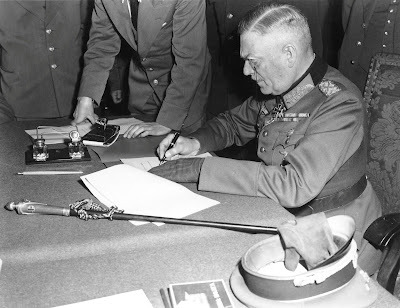Tuesday 8th May 1945 marked the official end of the fighting in Europe, although some combat took place after that date as not all German forces had surrendered.
The surrender was authorised by Hitler's successor, Reichspräsident (formerly Großadmiral) Karl Dönitz and Act of Military Surrender took place at Supreme Headquarters Allied Expeditionary Force (SHAFE) headquarters in Reims, France at 02:41 local time on 7th May. This was followed at 22:43 local time on 8th May by the signing of the definitive German Instrument of Surrender at Karlsorst in Berlin.
This stated that:
- We the undersigned, acting by authority of the German High Command, hereby surrender unconditionally to the Supreme Commander, Allied Expeditionary Force and simultaneously to the Supreme High Command of the Red Army all forces on land, at sea, and in the air who are at this date under German control.
- The German High Command will at once issue orders to all German military, naval and air authorities and to all forces under German control to cease active operations at 23.01 hours Central European time on 8 May 1945, to remain in all positions occupied at that time and to disarm completely, handing over their weapons and equipment to the local allied commanders or officers designated by Representatives of the Allied Supreme Commands. No ship, vessel, or aircraft is to be scuttled, or any damage done to their hull, machinery or equipment, and also to machines of all kinds, armament, apparatus, and all the technical means of prosecution of war in general.
- The German High Command will at once issue to the appropriate commanders, and ensure the carrying out of any further orders issued by the Supreme Commander, Allied Expeditionary Force and by the Supreme Command of the Red Army.
- This act of military surrender is without prejudice to, and will be superseded by any general instrument of surrender imposed by, or on behalf of the United Nations and applicable to Germany and the German armed forces as a whole.
- In the event of the German High Command or any of the forces under their control failing to act in accordance with this Act of Surrender, the Supreme Commander, Allied Expeditionary Force and the Supreme High Command of the Red Army will take such punitive or other action as they deem appropriate.
- This Act is drawn up in the English, Russian and German languages. The English and Russian are the only authentic texts.
It was signed or witnessed by the following representatives of the Allies:
- Soviet Union: Marshal Georgy Zhukov, on behalf of the Supreme High Command of the Red Army
- United Kingdom: Air Chief Marshal Sir Arthur William Tedder, as Deputy Supreme Commander of the Allied Expeditionary Force
- United States: General Carl Spaatz, Commanding United States Strategic Air Forces,
- France: General Jean de Lattre de Tassigny, Commanding First French Army
It was signed or witnessed on behalf of Germany by:
- Generalfeldmarschall Wilhelm Keitel, as the Chief of the General Staff of the German Armed Forces (Wehrmacht)
- Generaladmiral Hans-Georg von Friedeburg, as Commander-in-Chief of the German Navy
- Generaloberst Hans-Jürgen Stumpff, as the representative of the Luftwaffe
Generalfeldmarschall Wilhelm Keitel signing the German Instrument of Surrender on 8th May 1945.
The news was greeted with celebrations across Europe, although some were more muted than others. My father, who was in Wismar on the Baltic coast of Germany on VE-Day, remembered celebrating with a bottle of warm beer, and my father-in-law, who was in Delhi, India, did not celebrate at all.
























.jpeg)










May, not June!
ReplyDeleteTim Spanton,
DeleteWhat a typo to make! It’s now been corrected.
All the best,
Bob